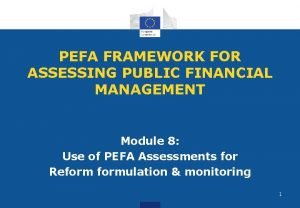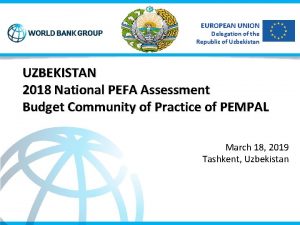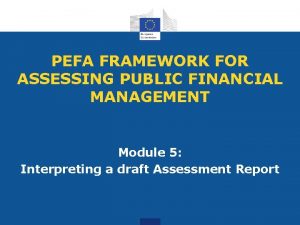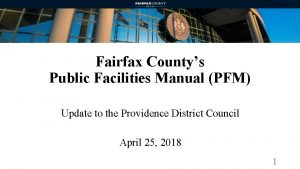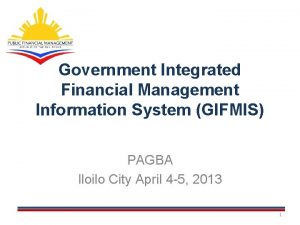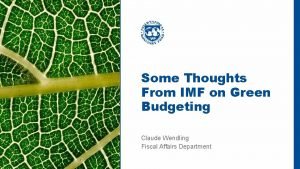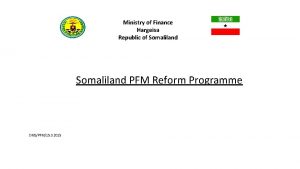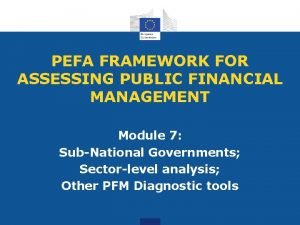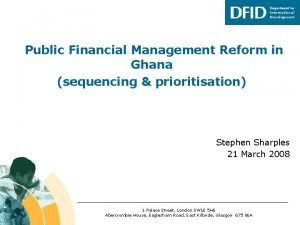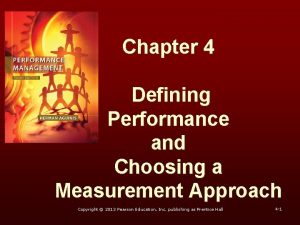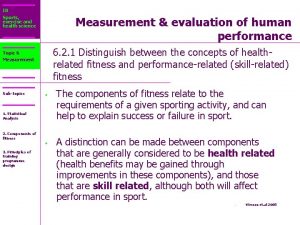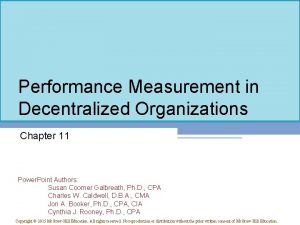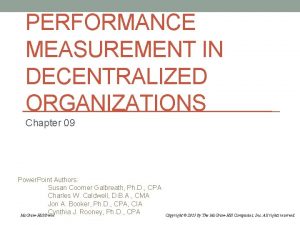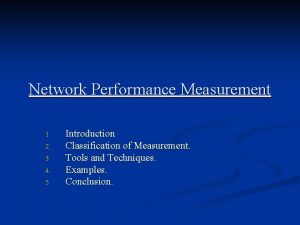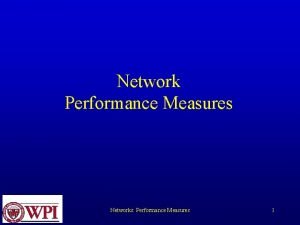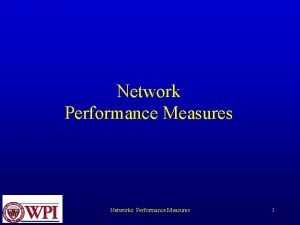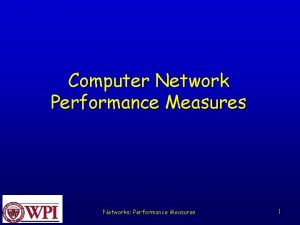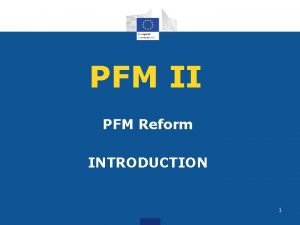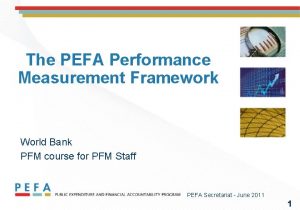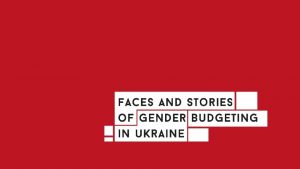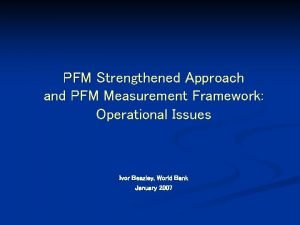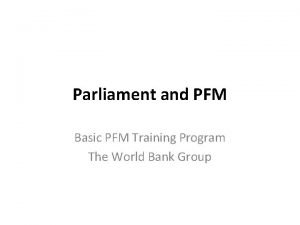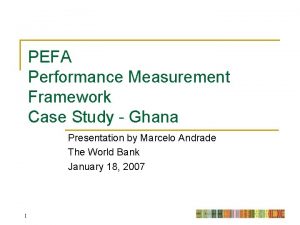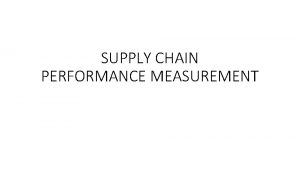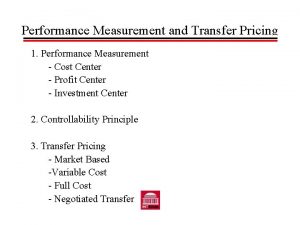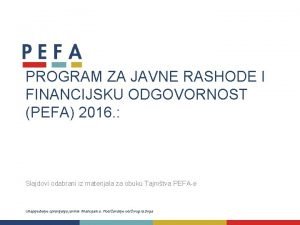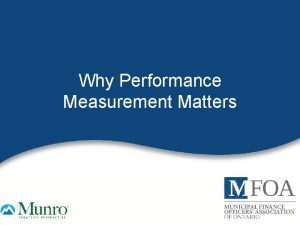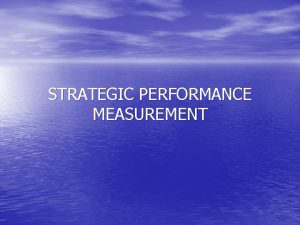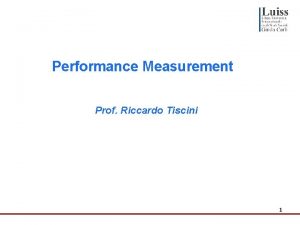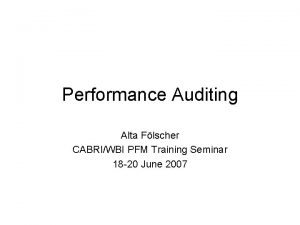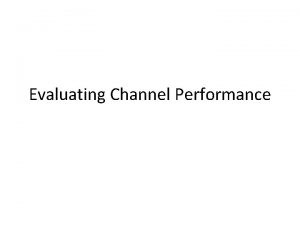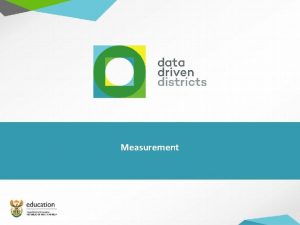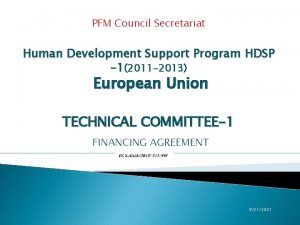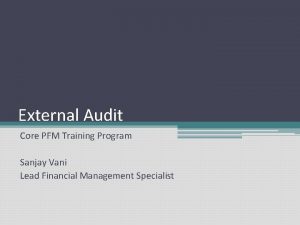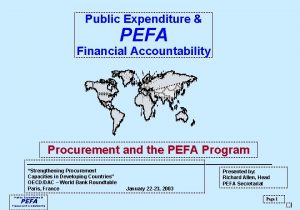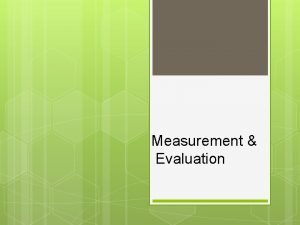The PEFA Program and the PFM Performance Measurement






























- Slides: 30

The PEFA Program – and the PFM Performance Measurement Framework Public Financial Analysis and Management (PFAM) Course World Bank Washington DC, April 24, 2007 Frans Ronsholt PEFA Secretariat 1

Content l l l 2 What is PEFA ? The Strengthened Approach to Supporting PFM Reform The PFM Performance Measurement Framework Roll-out of the Framework Assessment Process Issues The Role of the PEFA Secretariat

What is PEFA ? l Public Expenditure and Financial Accountability Program – – l Established by a core group of international financial institutions and donor agencies – – l l World Bank, IMF, European Commission, UK, France, Norway, Switzerland Guides and finances the Program Working closely with other donor agencies – 3 aimed at harmonization and alignment supporting the Monterrey, Rome and Paris Declarations through the OECD-DAC Joint Venture on PFM PEFA Secretariat located within World Bank

PFM Diagnostics in the 1990 s l Large amount of PFM work undertaken, – – 4 mostly by development agencies a good deal of knowledge generated. LIMITATIONS l Duplication and lack of coordination led to heavy burden on partner governments. l Not possible to demonstrate improvements in PFM performance over time in a country l Monitoring of PFM reforms focused on inputs and activities, rather than performance

The Strengthened Approach to Supporting PFM Reform l A country-led PFM reform program – l A donor coordinated program of support – l covering analytical, technical and financial support A common information pool – – 5 including a strategy and action plan reflecting country priorities; implemented through government structures based on a framework for measuring and monitoring results over time i. e. the PEFA PFM Performance Measurement Framework

The PFM Performance Measurement Framework 6

Components of the Framework l A standard set of high level PFM indicators to assess performance – – l A concise, integrated report – the PFM Performance Report – – – 7 28 government performance indicators 3 donor indicators, reflecting donor practices influencing the government’s PFM Standard content and format provides the narrative to support the indicator assessments (the evidence) draws a summary from the analysis

Coverage of the Public Sector § Focused on central government operations § Links to other parts of the public sector - Sub-National Governments Public Business Enterprises to the extent these have implications for Central Government § May be applied to sub-national government - Requires minor modifications 8

Principles of Indicator Design • High level system performance is measured • Assesses performance, but not underlying capacity factors • Full overview of the PFM system • revenue, expenditure, procurement, financial assets/ liabilities • Basis for design: 9 • The 16 HIPC Expenditure Tracking Indicators, but broader • draws on IMF’s Fiscal Standards and Codes (ROSC) • internationally accepted standards e. g. GFS, IPSAS, INTOSAI • Widely applicable to countries at all levels of development, but not intended for cross-country comparison

Structure of the Indicator Set C. Budget Cycle Policy Based budgeting D. Donor Practices A. PFM Out-turns External scrutiny and audit 10 B. Cross-cutting features Comprehensiveness and Transparency Accounting, Recording, Reporting Predictability and control in Budget Execution Budget credibility

Content of Indicator Set A. PFM Out-turns Credibility of the budget Indicators 1 - 4 Deviations from aggregate budgeted expenditure and revenue as well as expenditure composition. Level of expenditure arrears. B. Key Cross-cutting issues Comprehensiveness and transparency Indicators 5 -10 Coverage of budget classification, budget documentation, reporting on extra-budgetary operations, inter-governmental fiscal relations, fiscal risk oversight and public access to information. C. Budget Cycle i. Policy-based budgeting Indicators 11 -12 Annual budget preparation process, multi-year perspective in fiscal planning, expenditure policy and budgeting 11

Content of Indicator Set (cont’d) C. Budget Cycle ii. Predictability & control in budget execution Indicators 13 -21 Revenue administration, predictability in availability of funds, cash balances, debt & guarantee management, payroll controls, procurement, internal controls and internal audit iii. Accounting, recording and reporting Indicators 22 -25 Accounts reconciliation, reporting on resources at service outlet level, inyear budget execution reports, financial statements iv. External scrutiny and audit Indicators 26 -28 Scope, nature and follow-up on external audit; legislative scrutiny of annual budget law and external audit reports D. 12 Donor Practices Indicators D 1 - D 3 Predictability of direct budget support; donor information for budgeting and reporting; use of national procedures

Calibration and Scoring l Calibrated on four point ordinal scale (A, B, C, D) – 13 Requirements for each score explicitly specified l Scoring based on extent of internationally recognized ‘Good Practice’ l Indicators have 1, 2, 3 or 4 dimensions l – in total 74 dimensions – to provide detailed information & transparency of score – each dimension must be rated separately Aggregation only from dimensions to indicator

Roll-out of PEFA based Assessments 14

Roll-out of PFM Assessments l l PFM Performance Measurement Framework launched June 2005 Assessment Status as at March 2007 – – l Outlook for mid 2008 – – 15 45 substantially completed i. e. draft/final report 24 on-going but report not yet issued 27 agreed with government but not started Roll-out rate: a steady 2 -3 new assessments per month 75 -80 countries covered 8 -10 repeat assessments

Geographical distribution 16

Assessment Process Issues 17

Decentralized Process l Application of the PEFA Framework to be decided at country level. Decisions to be made: – – – l l 18 If and Why ? When ? How ? Recommended by international organizations as good practice (e. g. OECD-DAC, Com. Sec) No supra-agency mandates or responsibilities. Each country and organization decides its interest in a PEFA assessment and ability to contribute.

Government Involvement Government’s role § § § Self-assessment (with external validation) Joint assessment (joint team) Collaboration with donor-led assessment Determined by interest and capacity § § 19 What are the benefits to government? Government staff may need training

Donor Collaboration A donor reference group is essential § to ensure that needs of all parties are addressed § to ensure common acceptance of findings The reference group to agree internally and with the government on: § § 20 Diagnostic packaging Resources for assessment work Stages and timing of the assessment work Quality assurance arrangements

Diagnostic Packaging Purposes of Standard Diagnostic Tools 21

Diagnostic Packaging – Coverage of PFM Performance Report Implement PFM reforms High level performance overview Formulate PFM reform program PFM-PR Identify main PFM weaknesses Recommend PFM reform measures 22 Investigate underlying causes

Diagnostic Packages l l Stand-alone PFM-PR - Recommended -e. g. input to decision on focus of subsequent in-depth analysis PFM Performance indicators integrated into other product - in combination with PER, CFAA or PEMFAR/CIFA - a problematic concept; rarely working well l 23 PFM-PR as a separate/early module of a broader analytical product - often works well (e. g. Afghanistan PER, Ghana ERPFM)

Quality Assurance l l Terms of Reference & Draft Report to be Q. A. ’d Government and donor reference group – l Should ensure that information is used correctly and reflects the situation in the country Donor specific arrangements to be respected e. g. World Bank peer review mechanism l The PEFA Secretariat can contribute as peer reviewer, if requested – 24 Will consider if the product respects the Framework’s standards and methodology

The PEFA Secretariat 25

Mission of the PEFA Secretariat l l l 26 To disseminate information on the Strengthened Approach to Supporting PFM Reform and the PEFA Performance Measurement Framework. To support applications of the PEFA Framework at country level for quality and usefulness of the assessments. Reports to the seven-agency PEFA Steering Committee

Activities of the PEFA Secretariat l l 27 Development of the Framework; interpretation and clarification of the indicators Provision of support and guidance for quality in implementing the assessment in each country Development of training programs and materials Monitoring roll-out of the strengthened approach for lesson learning and input into training and guidance

Support Services and Tools Support tools for assessment managers on the website (www. pefa. org): l l List of completed, ongoing and planned assessments – updated 3 -4 times annually Links to completed reports, if they are made public Support to assessment managers on request: l l l 28 l Advice / Video-conference briefings to country teams on assessment planning List of consultants with PEFA assessment experience Review of terms of reference Quality reviews of draft assessment reports

Support Services and Tools Support tools for assessors & trainers on the website: l l l Translations of the Framework (English, French, Spanish, Portuguese, Russian, Arabic) Calculation spreadsheets for some indicators Guidance on information / evidence for assessment Clarifications and additional guidance on indicators Training materials Support to assessors on request: l 29 Indicator interpretation and other advice to assessors during implementation

Thank You for Your Attention 30
 Pefa framework
Pefa framework Pefa pillars
Pefa pillars Pefa framework
Pefa framework Progress and performance measurement and evaluation
Progress and performance measurement and evaluation Evaluation in progress
Evaluation in progress Fairfax county public facilities manual
Fairfax county public facilities manual Pfm devices
Pfm devices Pagba budget
Pagba budget Pfm roofing
Pfm roofing Somaliland pfm
Somaliland pfm Pfm asset management
Pfm asset management Pfm somaliland learning
Pfm somaliland learning Diagnostic tools for pfm
Diagnostic tools for pfm Pufmarp
Pufmarp Approaches to measuring performance
Approaches to measuring performance Approaches to measuring performance
Approaches to measuring performance Measurement and evaluation in human performance 5e download
Measurement and evaluation in human performance 5e download Measurement and evaluation in human performance
Measurement and evaluation in human performance Performance measurement in decentralized organizations
Performance measurement in decentralized organizations Performance measurement in decentralized organizations
Performance measurement in decentralized organizations Network performance measurement tools
Network performance measurement tools Performance measurement guide for information security
Performance measurement guide for information security Comparative performance measurement system
Comparative performance measurement system Network performance measurement tools
Network performance measurement tools Quantum performance measurement
Quantum performance measurement Network performance measurement in computer networks
Network performance measurement in computer networks Network performance measurement in computer networks
Network performance measurement in computer networks Router node
Router node Chapter 11 performance appraisal - (pdf)
Chapter 11 performance appraisal - (pdf) Performance appraisal process
Performance appraisal process Jcids manual
Jcids manual
